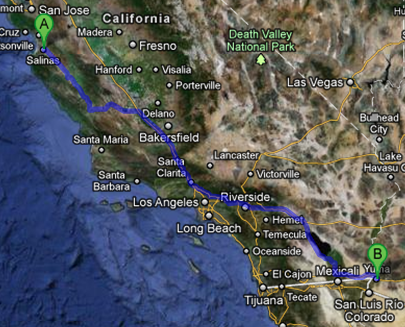News and Stories
On the Move
—Mark Shaw and Mike Downey
Imagine owning a business that produces thousands of pounds of fresh fruits and vegetables per year. Now imagine having to move that company 575 miles away…and not only move it, but pack all of your machinery piece-by-piece into trucks, haul it north, unpack and reassemble everything, and be ready to operate in only two days. Sounds ridiculous, right?
Would it surprise you to learn that the majority of West Coast companies that cultivate lettuce and leafy greens do this twice every year?
That’s right, this past weekend most of these businesses including many of Markon’s suppliers of Markon First Crop and Ready-Set-Serve products closed shop on Thursday, April 5 in Yuma, Arizona and reopened for business Sunday, April 8 in Salinas, California.

(Image from Google Maps)
Here’s what you can expect during the Salinas growing season:
The best quality vegetables are usually harvested from mid-May through late July/mid-August.
- Mother Nature typically shines on the Salinas Valley from April through early to mid-June, allowing vegetables to develop/mature and produce the best quality and highest yields possible
- The Salinas Valley has a built-in air conditioner in the form of warm daylight temperatures followed by cool, crisp nights that is ideal for growing fresh vegetables
- From early to mid-June, a marine layer (or fog as the locals call it) rolls into the valley from the Monterey Bay by early evening, cooling air temperatures down, then rolls back out to the coast between 7:00 a.m. and early afternoon
- The Salinas Valley is one of the most fertile areas in the world
- An alluvial silty/clay soil sits from the mouth of the valley inland for roughly 20 miles
- Beyond that, farther inland, is sandy loam
- The different soil types and varied daytime temperatures allow for a seven-month growing window
- The farther the vegetables are grown from the coast, the warmer the daytime temperatures become (think of that built-in air conditioner)
- Vegetables are harvested early in the season: May-June in the southern part of the valley; from mid-June through August, the harvest is concentrated closer to the coast due to the cooler, fog-related temperatures at night
This year’s harvesting transition is already in the works and the growers are prepared for another season of hard work and diligent farming, resulting in the high-quality produce the rest of us will eat and serve all summer long. Enjoy and serve it with the pride of knowing how much went into growing your delicious ingredients.
For more information about the seasonal harvesting transition and growing regions, check out these links:
